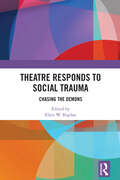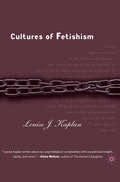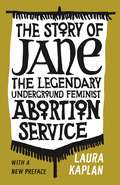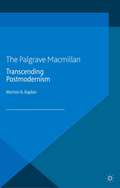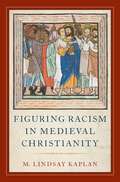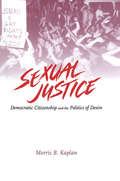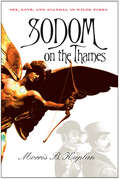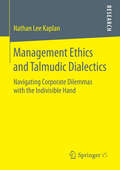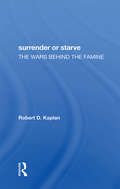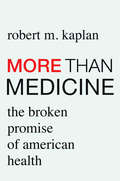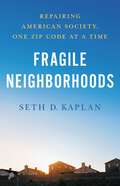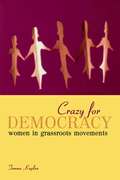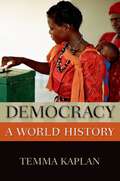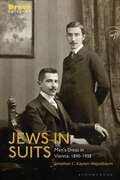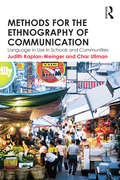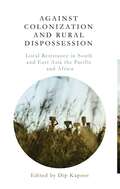- Table View
- List View
Theatre Responds to Social Trauma: Chasing the Demons (Routledge Series in Equity, Diversity, and Inclusion in Theatre and Performance)
by Ellen W. KaplanThis book is a collection of chapters by playwrights, directors, devisers, scholars, and educators whose praxis involves representing, theorizing, and performing social trauma.Chapters explore how psychic catastrophes and ruptures are often embedded in social systems of oppression and forged in zones of conflict within and across national borders. Through multiple lenses and diverse approaches, the authors examine the connections between collective trauma, social identity, and personal struggle. We look at the generational transmission of trauma, socially induced pathologies, and societal re-inscriptions of trauma, from mass incarceration to war-induced psychoses, from gendered violence through racist practices. Collective trauma may shape, protect, and preserve group identity, promoting a sense of cohesion and meaning, even as it shakes individuals through pain. Engaging with communities under significant stress through artistic practice offers a path towards reconstructing the meaning(s) of social trauma, making sense of the past, understanding the present, and re-visioning the future.The chapters combine theoretical and practical work, exploring the conceptual foundations and the artists’ processes as they interrogate the intersections of personal grief and communal mourning, through drama, poetry, and embodied performance.
The Cycle of Deviant Behavior: Investigating Intergenerational Parallelism (Longitudinal Research in the Social and Behavioral Sciences: An Interdisciplinary Series)
by Howard B. Kaplan Glen C. Tolle Jr.To conduct this study on criminal and antisocial behavior, the authors devoted years to collecting data from a large community sample of first-generation subjects. Data were garnered throughout their early adolescence, twenties, and thirties as well as from these first-generation subjects’ biological children during their own early adolescence. The results of these studies have profound implications for future research and methodology on deviant behavior.
Cultures of Fetishism
by L. KaplanIn her latest book, Dr. Louise Kaplan, author of the groundbreaking Female Perversions , explores the fetishism strategy, a psychological defense that aims to tame, subdue, and if necessary, murder human vitalities. Through an exploration of such cultural phenomena as footbinding, reality television, and the construction of robots, Kaplan demonstrates how, in a technology-driven world, an understanding of the fetishism strategy can help to preserve the human dialogue that is the basis of all human relationships. Kaplan writes from the heart as well as from the intellect.
The Story of Jane: The Legendary Underground Feminist Abortion Service
by Laura Kaplan"In the four years before the Supreme Court's 1973 Roe vs. Wade decision, most women determined to get abortions had to subject themselves to the power of illegal, unregulated abortionists...But a Chicago woman who happened to stumble across a secret organization code-named 'Jane' had an alternative. Laura Kaplan, who joined Jane in 1971, has pieced together the histories of the anonymous (here identified only by pseudonyms), average-sounding women who transformed themselves into outlaws."—Cleveland Plain Dealer "The Story of Jane is a piece of women's history in step with feminist theory demanding that women tell their own stories. It serves to remind people of an important and often overlooked moment in the women's rights movement."—Seattle Weekly "Laura Kaplan's The Story of Jane is the first book to chronicle this controversial sliver of history, and it is a fascinating, if partisan, close-up of the group."—Newsday "[Kaplan] draws on her personal recollections and interviews with Jane members and clients and the doctors who performed the abortions to provide a well-written, detailed history of this radical group."—Publisher's Weekly "Weaving together the voices and memories of her former co-workers, Kaplan recounts how the group initially focused on counseling women and helping them find reliable, reasonably priced doctors....Kaplan's account of this remarkable story recaptures the political idealism of the early '70s...23 years after Roe vs. Wade, the issues and memories raised by the books are close and all too relevant."—K Kaufmann, San Francisco Chronicle "Laura Kaplan's The Story of Jane is the first book to chronicle this controversial sliver of history, and it is a fascinating, if partisan, close-up of the group....The Story of Jane succeeds on the steam of Kaplan's gripping subject and her moving belief in the power of small-scale change."—Cynthia Leive, New York Newsday "During the four years before the Supreme Court's Roe v. Wade decision legalized abortion in 1973, the 100 members of Jane helped some 11,000 women end their pregnancies....There is more in this remarkable book that will further raise eyebrows....Kaplan's engrossing tales of the quiet courage of the women who risked their reputations and freedom to help others may remind many readers of other kinds of outlaws who have resisted tyranny throughout history."—Chicago Sun-Times
Transcending Postmodernism
by M. Kaplan I. Hamati-AtayaContemporary philosophy is torn between a reliance on the pragmatic meanings of designated objects and a foundation based on formal theory. This book shows that philosophical knowledge, which no more has a terminal state than an infinite set has a last term, advances when the dialectical relationship between the two approaches is synthesized. The choice of designations is intimately related to theory and the form of theory is intimately related to the character of designated objects. The intimate dialectical relationship between theory and meaning is explored in detail in the area of international theory. The recent emphasis on realism rests on a regressive misunderstanding of the dialectical relationship between theory and practice that loses Newton's acute understanding of it, an understanding that underlies the great advances of physics, and that is lost in the contemporary social sciences.
Figuring Racism in Medieval Christianity
by M. Lindsay KaplanIn Figuring Racism in Medieval Christianity, M. Lindsay Kaplan expands the study of the history of racism through an analysis of the Christian concept of Jewish hereditary inferiority. Imagined as a figural slavery, this idea anticipates modern racial ideologies in creating a status of permanent, inherent subordination. Unlike other studies of early forms of racism, this book places theological discourses at the center of its analysis. It traces an intellectual history of the Christian doctrine of servitus Judaeorum, or Jewish enslavement, imposed as punishment for the crucifixion. This concept of hereditary inferiority, formulated in patristic and medieval exegesis through the figures of Cain, Ham, and Hagar, enters into canon law to enforce the spiritual, social, and economic subordination of Jews to Christians. Characterized as perpetual servitude, this status shapes the construction of Jews not only in canon law, but in medicine, natural philosophy, and visual art. By focusing on inferiority as a category of analysis, Kaplan sharpens our understanding of contemporary racism as well as its historical development. The damaging power of racism lies in the ascription of inferiority to a set of traits and not in bodily or cultural difference alone; in the medieval context, theological authority affirms discriminatory hierarchies as a reflection of divine will. Medieval theological discourses created a racial rationale of Jewish hereditary inferiority that also served to justify the servile status of Muslims and Africans. Kaplan's discussion of this history uncovers the ways in which racism circulated in pre-modernity and continues to do so in contemporary white supremacist discourses that similarly seek to subordinate these groups.
Figuring Racism in Medieval Christianity
by M. Lindsay KaplanIn Figuring Racism in Medieval Christianity, M. Lindsay Kaplan expands the study of the history of racism through an analysis of the Christian concept of Jewish hereditary inferiority. Imagined as a figural slavery, this idea anticipates modern racial ideologies in creating a status of permanent, inherent subordination. Unlike other studies of early forms of racism, this book places theological discourses at the center of its analysis. It traces an intellectual history of the Christian doctrine of servitus Judaeorum, or Jewish enslavement, imposed as punishment for the crucifixion. This concept of hereditary inferiority, formulated in patristic and medieval exegesis through the figures of Cain, Ham, and Hagar, enters into canon law to enforce the spiritual, social, and economic subordination of Jews to Christians. Characterized as perpetual servitude, this status shapes the construction of Jews not only in canon law, but in medicine, natural philosophy, and visual art. By focusing on inferiority as a category of analysis, Kaplan sharpens our understanding of contemporary racism as well as its historical development. The damaging power of racism lies in the ascription of inferiority to a set of traits and not in bodily or cultural difference alone; in the medieval context, theological authority affirms discriminatory hierarchies as a reflection of divine will. Medieval theological discourses created a racial rationale of Jewish hereditary inferiority that also served to justify the servile status of Muslims and Africans. Kaplan's discussion of this history uncovers the ways in which racism circulated in pre-modernity and continues to do so in contemporary white supremacist discourses that similarly seek to subordinate these groups.
The Structural Approach in Psychological Testing: Pergamon General Psychology Series
by Marvin L. Kaplan Nick J. Colarelli Ruth Brill GrossThe Structural Approach in Psychological Testing covers the basic concepts for various types of personality or for the specific relationships of treatment possibilities to personality disturbances. The book describes the structural approach in psychological evaluation and its relation to developments in psychology in general and clinical psychology; the psychoanalytic foundations of the structural theory; and structural concepts in test analysis and personality description. The text also discusses the structural concepts to schizophrenia in developing the theoretical framework of schizophrenia as faulty ego synthesis, as well as the structural approach using case materials. The vacillation between reality and psychosis and the system of warding off confusion are also encompassed.
Sexual Justice: Democratic Citizenship and the Politics of Desire
by Morris B. KaplanSexual Justice defends a robust a robust conception of lesbian and gay rights, emphasizing protection against discrimination and recognition of queer relationships and families. Synthesizing materials from law, philosophy, psychoanalysis and literature, Kaplan argues that sexual desire is central to the pursuit of happiness: equal citizenship requires individual freedom to shape oneself through a variety of intimate associations.
Sexual Justice: Democratic Citizenship and the Politics of Desire
by Morris B. KaplanSexual Justice defends a robust a robust conception of lesbian and gay rights, emphasizing protection against discrimination and recognition of queer relationships and families. Synthesizing materials from law, philosophy, psychoanalysis and literature, Kaplan argues that sexual desire is central to the pursuit of happiness: equal citizenship requires individual freedom to shape oneself through a variety of intimate associations.
Sodom on the Thames: Sex, Love, and Scandal in Wilde Times
by Morris B. KaplanSodom on the Thames looks closely at three episodes involving sex between men in late-nineteenth-century England. Morris Kaplan draws on extensive research into court records, contemporary newspaper accounts, personal correspondence and diaries, even a pornographic novel. He focuses on two notorious scandals and one quieter incident. In 1871, transvestites "Stella" (Ernest Boulton) and "Fanny" (Frederick Park), who had paraded around London's West End followed by enthusiastic admirers, were tried for conspiracy to commit sodomy. In 1889–1890, the "Cleveland Street affair" revealed that telegraph delivery boys had been moonlighting as prostitutes for prominent gentlemen, one of whom fled abroad. In 1871, Eton schoolmaster William Johnson resigned in disgrace, generating shockwaves among the young men in his circle whose romantic attachments lasted throughout their lives. Kaplan shows how profoundly these scandals influenced the trials of Oscar Wilde in 1895 and contributed to growing anxiety about male friendships. Sodom on the Thames reconstructs these incidents in rich detail and gives a voice to the diverse people involved. It deepens our understanding of late Victorian attitudes toward urban culture, masculinity, and male homoeroticism. Kaplan also explores the implications of such historical narratives for the contemporary politics of sexuality.
Management Ethics and Talmudic Dialectics: Navigating Corporate Dilemmas with the Indivisible Hand
by Nathan Lee KaplanNathan Lee Kaplan develops a talmudic perspective on management ethics. By analyzing the central ethical dilemmas of corporate managers in light of applicable traditions from the Oral Torah, this book offers a critical bridge between the contemporary business corporation and rabbinic Judaism’s foundational tradition. The issues studied thereby include organizational culture, fraud and corruption, whistle-blowing, investor and employment relations, executive compensation, corporate social responsibility and environmental sustainability.
Surrender Or Starve: The Wars Behind The Famine
by Robert D KaplanFamine in the Horn is both a tool and an aspect of ethnic conflict, with the Ethiopian Amharas of the central highlands pitted against the Eritreans and Tigreans of the north. The overwhelming majority of U.S. journalists have reported on Ethiopia from one side only-that of the Amharas in Addis Ababa. The author wants to show the story from the other side, in order to redress a grievous imbalance in news coverage. To get people excited, you sometimes have to light a fire, and that was the author’s intention. This book covers the period from late 1984 to the early part of 1987. In late 1987, the famine returned, mainly for the very reasons cited inside.
Surrender Or Starve: The Wars Behind The Famine
by Robert D KaplanFamine in the Horn is both a tool and an aspect of ethnic conflict, with the Ethiopian Amharas of the central highlands pitted against the Eritreans and Tigreans of the north. The overwhelming majority of U.S. journalists have reported on Ethiopia from one side only-that of the Amharas in Addis Ababa. The author wants to show the story from the other side, in order to redress a grievous imbalance in news coverage. To get people excited, you sometimes have to light a fire, and that was the author’s intention. This book covers the period from late 1984 to the early part of 1987. In late 1987, the famine returned, mainly for the very reasons cited inside.
More than Medicine: The Broken Promise of American Health
by Robert M. KaplanAmerican science produces the best medical treatments in the world. Yet U.S. citizens lag behind in life expectancy and quality of life. Robert Kaplan marshals extensive data to make the case that U.S. health care priorities are sorely misplaced—invested in attacking disease, not in solving social problems that engender disease in the first place.
Fragile Neighborhoods: Repairing American Society, One Zip Code at a Time
by Seth D. KaplanAn &“essential and engaging &” (Richard Florida) exploration of social decline in America: its true causes and the practical steps each of us can take to combat it, starting with the places we call home. The neighborhoods we live in impact our lives in so many ways: they determine who we know, what resources and opportunities we have access to, the quality of schools our kids go to, our sense of security and belonging, and even how long we live. Yet too many of us live in neighborhoods plagued by rising crime, school violence, family disintegration, addiction, alienation, and despair. Even the wealthiest neighborhoods are not immune; while poverty exacerbates these challenges, they exist in zip codes rich and poor, rural and urban, and everything in between. In Fragile Neighborhoods, fragile states expert Seth D. Kaplan offers a bold new vision for addressing social decline in America, one zip code at a time. By revitalizing our local institutions—and the social ties that knit them together—we can all turn our neighborhoods into places where people and families can thrive. Readers will meet the innovative individuals and organizations pioneering new approaches to everything from youth mentoring to affordable housing: people like Dreama, a former lawyer whose organization works with local leaders and educators in rural Appalachia to equip young people with the social support they need to succeed in school; and Chris, whose Detroit-based non-profit turns vacant school buildings into community resource hubs. Along the way, Kaplan offers a set of practical lessons to inspire similar work, reminding us that when change is hyperlocal, everyone has the opportunity to contribute.
Crazy for Democracy: Women in Grassroots Movements
by Temma KaplanCrazy for Democracy vividly shows, through the lives of six women in the United States and South Africa, just what can be and is being accomplished to change our lives. At a time when we're depressed about democracy, pessimistic about race relations, and anxious about feminism, Crazy for Democracy vividly shows, through the lives of six women in the United States and South Africa, just what can be and is being accomplished to change our lives. In building real social movements to achieve a safe environment, win human rights, and safeguard their homes, these grassroots feminist leaders have been creating democratic institutions to achieve social justice for us all.
Crazy for Democracy: Women in Grassroots Movements
by Temma KaplanCrazy for Democracy vividly shows, through the lives of six women in the United States and South Africa, just what can be and is being accomplished to change our lives. At a time when we're depressed about democracy, pessimistic about race relations, and anxious about feminism, Crazy for Democracy vividly shows, through the lives of six women in the United States and South Africa, just what can be and is being accomplished to change our lives. In building real social movements to achieve a safe environment, win human rights, and safeguard their homes, these grassroots feminist leaders have been creating democratic institutions to achieve social justice for us all.
Democracy: A World History (New Oxford World History)
by Temma KaplanIn our time, the term "democracy" is frequently evoked to express aspirations for peace and social change or particular governmental systems that claim to benefit more than a select minority of the population. In this book, Temma Kaplan examines attempts from ancient Mesopotamia to the early twenty first century to create democratic governments that allow people to secure food, shelter, land, water, and peace for their mutual benefit. Since early times, proponents of direct or participatory democracy have come into conflict with the leaders of representative institutions that claim singular power over democracy. Patriots of one form or another have tried to reclaim the initiative to determine what democracy should mean and who should manage it. Frequently, people in small communities, trade unions, or repressed racial, religious, and political groups have marched forward using the language of democracy to carve a space for themselves and their ideas at the center of political life. Sometimes they have reinterpreted the old laws, and sometimes they have formulated new laws and institutions in order to gain greater opportunities to debate the major issues of their time. This book examines the development of the democratic ideal from ancient Rome to the Cortes in Spain, the philosophies of Guru Nanak and the Castilian patriot Juan de Padilla, and such inspirational personalities as the Polish trade unionist Anna Walentnyowicz and Burmese politician Aung San Suu Kyi. Though few democracies have sustained themselves for significant lengths of time, their emergence nearly everywhere on earth over thousands of years indicates their resilience despite the fragility of the democratic ideal.
Democracy: A World History (New Oxford World History)
by Temma KaplanIn our time, the term "democracy" is frequently evoked to express aspirations for peace and social change or particular governmental systems that claim to benefit more than a select minority of the population. In this book, Temma Kaplan examines attempts from ancient Mesopotamia to the early twenty first century to create democratic governments that allow people to secure food, shelter, land, water, and peace for their mutual benefit. Since early times, proponents of direct or participatory democracy have come into conflict with the leaders of representative institutions that claim singular power over democracy. Patriots of one form or another have tried to reclaim the initiative to determine what democracy should mean and who should manage it. Frequently, people in small communities, trade unions, or repressed racial, religious, and political groups have marched forward using the language of democracy to carve a space for themselves and their ideas at the center of political life. Sometimes they have reinterpreted the old laws, and sometimes they have formulated new laws and institutions in order to gain greater opportunities to debate the major issues of their time. This book examines the development of the democratic ideal from ancient Rome to the Cortes in Spain, the philosophies of Guru Nanak and the Castilian patriot Juan de Padilla, and such inspirational personalities as the Polish trade unionist Anna Walentnyowicz and Burmese politician Aung San Suu Kyi. Though few democracies have sustained themselves for significant lengths of time, their emergence nearly everywhere on earth over thousands of years indicates their resilience despite the fragility of the democratic ideal.
Jews in Suits: Men's Dress in Vienna, 1890-1938 (Dress Cultures)
by Jonathan C. Kaplan-WajselbaumSurviving photographs of Jewish Viennese men during the fin-de-siècle and interwar periods – both the renowned cultural luminaries and their many anonymous coreligionists – all share a striking sartorial detail: the tailored suit. Yet, until now, the adoption of the tailored suit and its function in the formation of modern Jewish identities remains under-researched.Jews in Suits uses a rich range of written and visual sources, including literary fiction and satire, 'ego-documents', photography, trade catalogues, invoices, and department store culture, to propose a new narrative of men, fashion, and their Jewish identities. It reveals that dressing in a modern manner was not simply a matter of assimilation, but rather a way of developing new models of Jewish subjectivity beyond the externally prescribed notion of 'the Jew'. Drawing upon fashionable dress, folk costume, religious dress, avant-garde, oppositional dress, typologies which are often considered separate from one another, it proposes a new way of reading men and clothing cultures within an iconic cultural milieu, offering insights into the relationship of clothing and grooming to the understanding of the self.
Jews in Suits: Men's Dress in Vienna, 1890-1938 (Dress Cultures)
by Jonathan C. Kaplan-WajselbaumSurviving photographs of Jewish Viennese men during the fin-de-siècle and interwar periods – both the renowned cultural luminaries and their many anonymous coreligionists – all share a striking sartorial detail: the tailored suit. Yet, until now, the adoption of the tailored suit and its function in the formation of modern Jewish identities remains under-researched.Jews in Suits uses a rich range of written and visual sources, including literary fiction and satire, 'ego-documents', photography, trade catalogues, invoices, and department store culture, to propose a new narrative of men, fashion, and their Jewish identities. It reveals that dressing in a modern manner was not simply a matter of assimilation, but rather a way of developing new models of Jewish subjectivity beyond the externally prescribed notion of 'the Jew'. Drawing upon fashionable dress, folk costume, religious dress, avant-garde, oppositional dress, typologies which are often considered separate from one another, it proposes a new way of reading men and clothing cultures within an iconic cultural milieu, offering insights into the relationship of clothing and grooming to the understanding of the self.
Methods for the Ethnography of Communication: Language in Use in Schools and Communities (1st Edition)
by Judith Kaplan-WeingerMethods for the Ethnography of Communication is a guide to conducting ethnographic research in classroom and community settings that introduces students to the field of ethnography of communication, and takes them through the recursive and nonlinear cycle of ethnographic research. Drawing on the mnemonic that Hymes used to develop the Ethnography of SPEAKING, the authors introduce the innovative CULTURES framework to provide a helpful structure for moving through the complex process of collecting and analyzing ethnographic data and addresses the larger how-to questions that students struggle with when undertaking ethnographic research. Exercises and activities help students make the connection between communicative events, acts, and situations and ways of studying them ethnographically. Integrating a primary focus on language in use within an ethnographic framework makes this book an invaluable core text for courses on ethnography of communication and related areas in a variety of disciplines. Methods for the Ethnography of Communication is a guide to conducting ethnographic research in classroom and community settings that introduces students to the field of ethnography of communication, and takes them through the recursive and nonlinear cycle of ethnographic research. Drawing on the mnemonic that Hymes used to develop the Ethnography of SPEAKING, the authors introduce the innovative CULTURES framework to provide a helpful structure for moving through the complex process of collecting and analyzing ethnographic data and addresses the larger how-to questions that students struggle with when undertaking ethnographic research. Exercises and activities help students make the connection between communicative events, acts, and situations and ways of studying them ethnographically. Integrating a primary focus on language in use within an ethnographic framework makes this book an invaluable core text for courses on ethnography of communication and related areas in a variety of disciplines.
Methods for the Ethnography of Communication: Language in Use in Schools and Communities (1st Edition) (PDF)
by Judith Kaplan-WeingerMethods for the Ethnography of Communication is a guide to conducting ethnographic research in classroom and community settings that introduces students to the field of ethnography of communication, and takes them through the recursive and nonlinear cycle of ethnographic research. Drawing on the mnemonic that Hymes used to develop the Ethnography of SPEAKING, the authors introduce the innovative CULTURES framework to provide a helpful structure for moving through the complex process of collecting and analyzing ethnographic data and addresses the larger how-to questions that students struggle with when undertaking ethnographic research. Exercises and activities help students make the connection between communicative events, acts, and situations and ways of studying them ethnographically. Integrating a primary focus on language in use within an ethnographic framework makes this book an invaluable core text for courses on ethnography of communication and related areas in a variety of disciplines. Methods for the Ethnography of Communication is a guide to conducting ethnographic research in classroom and community settings that introduces students to the field of ethnography of communication, and takes them through the recursive and nonlinear cycle of ethnographic research. Drawing on the mnemonic that Hymes used to develop the Ethnography of SPEAKING, the authors introduce the innovative CULTURES framework to provide a helpful structure for moving through the complex process of collecting and analyzing ethnographic data and addresses the larger how-to questions that students struggle with when undertaking ethnographic research. Exercises and activities help students make the connection between communicative events, acts, and situations and ways of studying them ethnographically. Integrating a primary focus on language in use within an ethnographic framework makes this book an invaluable core text for courses on ethnography of communication and related areas in a variety of disciplines.
Against Colonization and Rural Dispossession: Local Resistance in South & East Asia, the Pacific & Africa
by Dip KapoorUnder the guise of 'development', a globalizing capitalism has continued to cause poverty through dispossession and the exploitation of labour across the Global South. This process has been met with varied forms of rural resistance by local movements of displaced farm workers, small and landless (women) peasants, and indigenous peoples in South and East Asia, the Pacific and Africa, who are resisting the forced appropriation of their land, the exploitation of labour and the destruction of their ecosystems and ways of life.In this provocative new collection, engaged scholars and activists combine grounded case studies with both Marxist and anti-colonial analyses, suggesting that the developmental project is a continuation of the colonial project. The authors then demonstrate the ways in which these local struggles have attempted to resist colonization and dispossession in the rural belt, thereby contributing essential movement-relevant knowledge on these experiences in the Global South.A vital addition to the fields of critical development studies, political-sociology, agrarian studies and the anthropology of resistance, this book addresses academics and analysts who have either minimized or overlooked local resistances to colonial capital, especially in the Asia-Pacific and Africa regions.
